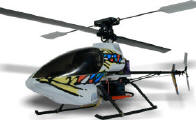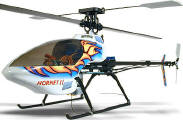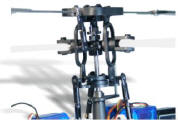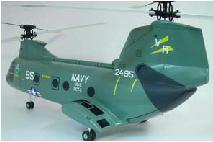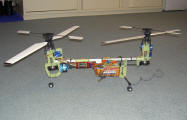MS Composit
A Czechoslovakian model importer founded in 1994 who moved into mini size RC helicopter development and production. MS produced a full range of rotor blades and also produced their own line of motors plus electronic control equipment so they could provide 'full' kits.
Current web site location - www.mscomposit.cz, they also have a "Facebook" page - www.facebook.com/pages/MS-COMPOSIT/230535980316620
Electronics notes
- 2004 - Twister X brushless motors for Hornet II
- 2004 - Twister range of ESC's
Rotor blades section to add...
MS Composit Hornet (2000#)
A small fixed pitch electric helicopter very much like the 'Piccolo' but had a direct tail drive instead of a separate small electric motor. The benefit of this being a fixed speed relationship between the main and tail blades so that tail control was by the 'normal' means of pushrod and moving tail blade holders. Not as simple as the separate motor method but a better form of tail control than relying on the available electronic mixers and non-heading hold micro gyros available at that time.
Specifications;
| Main rotor diameter | 490 mm |
| Length | 600 mm |
| Height | 160 mm |
| Weight | 240 to 280 g (depending upon equipment used) |
| Gear Ratio | 1 : 18 : 4 |
| Motor | Speed 300 |
| Rotor Speed | 1500 RPM (max) |
A five Amp speed controller was required along with suitable radio equipment (4 channel) and gyro (CSM 180); recommended battery was a 7 cell NiMH of 700 to 880mAh capacity which gave flight times of between six minutes for outdoor hard use or up to 12 minutes of 'training' hovering.
The basic kit was unassembled and came with the speed 300 motor; the full kit came with all the above recommended equipment on a frequency applicable to the country of delivery.
Hornet was voted 'Model of the year' at the Model-Hobby exhibition 2000.
Dave Day has an excellent range of articles covering the Hornet
For 2004 an upgrade kit was available to covert the model to Hornet CP rotor head specification.
MS Composit Hornet II (2003)
For 2003 the Hornet was updated for CCPM collective pitch control; basic specifications remained the same though its size and weight had increased slightly because of the update.
Revised specifications;
| Main rotor diameter | 560 mm |
| Length | 680 mm |
| Body Length | 510 mm |
| Weight | 320 to 340 g (depending upon equipment used) |
Whilst the model was aerobatic it did have limited control so for 2004 an upgrade for the rotor head was brought out to give Bell-Hiller mixing thus giving 3D capability.
For 2004 the model was renamed the Hornet CP (Bell-Hiller as standard TBC).
MS Composit Hornet X (2005)
For 2005 the model range was rationalised with the generic name 'Hornet X' which was available in three versions and also either as a kit or in ARF form;
Hornet X FP - Fixed pitch for beginners;
| Main rotor diameter | 490 mm |
| Fuselage Length | 510 mm |
| Weight | 320 g (depending upon equipment used) |
| Motor | Speed 300 (included in kit) |
| Battery | 7 or 8 cell NiMH 700 mAh |
Base line model with lifting main blades and height controlled by rotor speed.
Hornet X CP - Collective pitch for competent pilots;
This model had the same specification as the FP but with the collective head and larger semi-symmetrical section blades with rotor diameter now 560mm and a slight weight increase. Capable of aerobatic performance and 'mild' 3D flight.
Hornet X 3D - For advanced pilots;
| Main rotor diameter | 560 mm |
| Fuselage Length | 510 mm |
| Weight | 340 g (depending upon equipment used) |
| Motor | Twister EM 300/20 (included in kit) |
| Battery | 3 cell Li-Po 750 to 1200 mAh |
This model was a CP version and upgraded with a brushless motor thereby allowing 'hard' manoeuvres to be carried out and thus rating the '3D' title.
MS also produced a number of upgrade machined aluminium parts for the Hornet and in 2007 brought out the "Hornet X 3-D PRO" which incorporated all the possible upgrades and thus was the 'ultimate' Hornet.
MS Composit Schweiser 300 (2001#)
Scale version based on the Hornet and available as a basic kit or complete with radio equipment (35 or 40 MHz); alternatively a conversion kit was available if you already had an Hornet.
The Schweiser 300 was voted 'Model of the year' at the Model-Hobby exhibition 2001.
For 2004 an upgrade kit was available to covert the model to Hornet CP rotor head specification.
MS Composit CH-46 Sea Knight (2004)
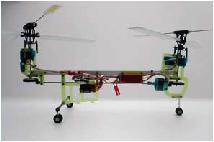
Electric 24th scale model of the CH-46 incorporating two CP Hornet head assemblies gear driven by a brushless motor. Like the Hirobo version
(though using non scale flybar heads) the blade discs overlapped and so that gear drive was necessary to keep both heads in synchronisation and prevent the blades for hitting each other. Control was by onboard mixer unit coupled to two gyros, one for normal rotation stabilization and the other aligned for pitch stability.
Specifications;
| Main rotor diameter | 490 mm |
| Body Length | 560 mm |
| Overall Length | 890 mm |
| Weight | 700 - 800g |
| Motor | Twister brushless (included in kit) |
The motor was supplied with the helicopter mechanics as it was of special design in that it had a 'through' shaft that one side directly drove the front rotor gearing and the other side drove the rear rotor gearing through drive shaft with flexible coupling.
The model was supplied as a basic mechanical kit without any of the electronics however as the mixer was not available anywhere by from MS it was more practical to pay the extra and get the recommended electronic pack however, this resulted in the full package being really expensive at over £600. I did buy one later in 2007 as I really wanted a twin rotor helicopter but as you will see in my notes below, I came to wish I had not...!!!
Whilst the three function of height, roll and rotation in twin rotor control are common, the control of pitch can be achieved in a number of ways and MS chose the more complicated path i.e. collective variation of the rotors plus mixing in cyclic changes. This results in a wide variation in the trimming possibilities and how the helicopter reacts which was to significantly complicate its flying ability. Note that the full size controlled pitch by collective operation of the rotors and not by cyclic inputs...???
My Sea Knight
Bought in 2007 and was one seriously frustrating helicopter. Once set up then it was sort of OK but any attempt at trimming to make it better eventually made it unflyable so had everything had to be to be reset and then trimming could start again.
>Mar 09 - Eventually found what might be the problem with the wayward handling; one of the side cyclic servo's on the front rotor was moving at only half the speed of the other two. The control system requires large movement for cyclic control but only small movement for pitch changes. Thus inputting a pitch change only gave a small cyclic change and was not really noticeable however, inputting a cyclic control resulted in a large pitch change and the nose would then significantly 'bounce' up or down. This would upset the whole trim requiring 'elevator' input which would compound things until it would near enough go out of control. In Sep-09 replacement servo fitted and again not quite as fast as the others though much nearer. Started from scratch and again spent ages trying to get it to be stable but without success. However teeters rubbers were very soft allowing the rotors to move a significant amount; about 50mm or more at the tips. Don't think that was right and intend to tighten up the teeter system to give near rigid rotors and see how that goes ; but model put in storage for long term until I feel the need to get it out and complete it as I
never actually got round to fitting the body....????
MS Composit Stinger 3 (2006)
Mini helicopter of the generic '450' size and thus capable of good outdoor flight; available as a kit or in ARF form;
Specifications;
| Main rotor diameter | 730 mm |
| Body Length | 680 mm |
| Overall Length | 890 mm |
| Weight | 900 g (depending upon equipment used) |
| Motor | Twister EM 650/8 |
| Battery | 3 or 4 cell L-Po 2000 to 3000 mAh |
MS also produced a number of upgrade machined aluminium parts for the Stinger and in 2007 brought out the "Stinger 3 PRO" which incorporated all the possible upgrades.
MS Composit Stinger 6 (2007)
Slightly larger version of the Stinger 3 and of the generic '480' size and thus only suitable for outdoor flight; available as a kit or in ARF form;
Specifications;
| Main rotor diameter | 860 mm |
| Body Length | 760 mm |
| Overall Length | 890 mm |
| Weight | 1000 g (depending upon equipment used) |
| Motor | Twister EM 650/8 |
| Battery | 3 or 4 cell L-Po 3000 to 4500 mAh |
As per the Stinger 3, also brought out in "PRO" form.
MS Composit AS 350 B-2 Ecureuil (2007)

Electric 20th scale model with brushless motor and three blade scale head; good level of scale detail such a rivets on the supplied body.
Specifications;
| Main rotor diameter | 564 mm |
| Body Length | 545 mm |
| Weight | 400 to 450 g (depending upon equipment used) |
| Motor | Twister EM 300/34 |
| Battery | 3 cell L-Po 1000 to 1500 mAh |
Kits options was either with or without the recommended Twister brushless motor.
MS Composit Protos (2008)
Full '500' size helicopter for 415 to 430 mm size rotor blades and 4S-6S battery packs depending upon performance required. Utilised an innovative drive system of a single belt that was driven from the motor and the drove both the main gear and the tail rotor. Full metal Hub and swashplate with composite material frames and the rotor head had adjustable mixing so as to cover performance both for beginners and advanced pilots.
Specifications;
| Main rotor diameter | 965 mm |
| Body Length | 545 mm |
| Weight | Up to 1520 g (depending upon equipment used) |
| Motor | Brushless 8000Kv 1100W for $s-6S Li-Po's |
| Main Gear | 97T |
| Pinion Gear | 15T to 20T (18T included in kit) |
| Flybar | 2mm with "Gorilla gear" programmable paddles |
| Battery | Li-Po from 4S - 3700 mAh to 6S - 2500 mAh |
Kit options included the recommended motor and / or the recommended CF blades.

